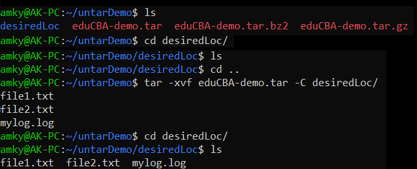
In this example we want to extract rar/rar.txt and rar/license.txt from the archive.
#Tar to untar in linux archive#
We can also extract multiple files without extracting the whole archive we will add all files and directories we want to extract one by by. $ tar -xvf rarlinux-圆4-5.4.0.tar.gz rar/rar.txt Extract Multiple Files In this example we will extract file rar/rar.txt from archive. We will specify the file or directory we want to extract after the archive name. In this example we will extract all content of the rarlinux-圆4-5.4.0.tar.gz $ tar -xvf rarlinux-圆4-5.4.0.tar.gz Extract Entire Archive Extract Single FileĪnother useful example is extracting single file from the tar.gz archive. Type at the command prompt tar xzf - to uncompress a gzip tar file (.tgz or. We will use tar command with -xvf option. Most of the time, the files will be extracted to the current folder (and the folder that holds them is most likely named ‘file-1.0’).
#Tar to untar in linux zip#
This will extract all file into new directory. How Do I Untar A Tar File In Linux Zip Zip files should have uncompress options by typing tar xzf or tar xjf file.Tar.

The most used operation is extracting entire archive. In this example we will list contents of rarlinux-圆4-5.4.0.tar.gz $ tar -tvf rarlinux-圆4-5.4.0.tar.gz List Files and Directories Extract Entire Tar.gz Archive We will use tar command with -tvf option to list them. List Files and Directoriesīefore extracting or uncompressing the tar.gz file we generally need to list file and directories in the archive. gz command is used to compress, extract and list files and directories.

Gz is the gzip format which is provided by all of the Linux, Unix and BSD files systems. Detailed tutorial about tar command be found in the following link. This is most used technique before compression. Tar is very old and popular format used to put separate file and directories into single file.
#Tar to untar in linux how to#
In this tutorial we will look how to extract them easily. As a Linux system administrator we generally face with tar.gz extension files. Example 1 Extraction of tar file Syntax: tar -xvf eduCBA-demo.tar Output Here we see that at first there are no such files present while we have the directory, but as we untar the file, all the file contents get extracted and uncompressed to the location where we are running the command from. you see creating tar file with gzip is very easy just use -z option and it will crate a gzip tar.tgz or tar.gz extension is used to denote tar file with. A lot of files like source code, backup, configuration files etc. This will list the contents of the tarball before you extract it so you can decide if you want to extract it to pwd as-is, or create a new directory and extract it from there.Tar and gz formats very popular in Linux, Unix and BSD world. To understand if you should tar -x or mkdir _ & cd _ & tar -x. In this situation, if you want to keep the extracted files in an isolated directory, you should: mkdir tarball & cd tarball & tar -xzf. In that case, when you tar -x, you'll get file1, file2, and file3 in the current directory. It's very possible for someone to compress an archive with: tar -czf file1 file2 file3 Lets break down this command and look into each flag. To compress them, well use tar like this: tar -czvf. In that case, if you tar -x it you'll get the contents extracted to somedirectory. We have a list of the following files which well compress with tar.

Meaning someone wrote: tar -czf somedirectory That being said, here's what that means, and how we can work around that to get the behaviour you want. Tar -x will extract the contents of the *.tar.* file to the present working directory.


 0 kommentar(er)
0 kommentar(er)
